Ptolemy's star catalogue and star calendar
Considering the translations
Two translation of the text have been seen: L'Abbe Halma's (1816)
and Schmidt's (1993). On this web page the English translation by
Schmidt (1993) has been used. Schmidt's translation is based on
Teubner's edition edited by Heiberg. Heiberg's edition of the Almagest
(1893-1903) marked a turning point in the study of Greek
astronomy according to Pedersen (1987, page 61), so it is expected
that the Phases edited by Heiberg is also of good quality.
One obvious typo was found in the English translation (Schmidt,
1993, page 43): star common to Eridanus and Andromeda on Mesori Day
4. The French version (L'Abbe Halma, 1816, page 50) helped to give
the obvious correct star: star common to Pegasus and Andromeda:
Alpheratz. All other entries look ok. Some improvements could
annotated by incorporating the stars' Phases and Type behavior.
The climata hours for many entries are different for both
translations. The influence of this does not seem to be significant,
as the resulting formula look comparable.
Considering the starting date of the calendar
The approximate 540 star entries (~270 MF&EL and ~270 AR&CS
events) from Ptolemy's calendar The phases of the fixed stars
were analysed. The star phases are explained on this webpage.
The calendar starts on Thoth Day 1 and this date has been equaled to
August 28th 58CE. A day is by the way using Ptolemy's definition:
from noon to noon (L'Abbe Halma, 1816, page 19). 58CE was used
because this seems to be the year that matches the closest to the
ecliptic coordinates in Ptolemy's Almagest (Peters and
Knobel, 1915, page 15). August 28th maps with the lowest standard
deviation for the date differences for the 4 solar events in the 12
month period mid 58CE to mid 59CE. That date is also mentioned in
L'Abbe Halma's translation (1816, page 21).
Star visibility
- In Ptolemy times, sky would be under perfect dark sky
conditions, as all light pollution would have been absent; stars
as faint as +7.5magn might be visible with the naked eye at
zenith (Clark, 1990, Fig. 2.8 page 16). M33 (magn=5.72) would
have been visible with direct vision (Bortle, 2001, page 126).
- All 1025 (unique) Ptolemy stars (Pratt, 2015) are included in
the sefstars.txt file for the
Opensource Swiss Ephemeris.
- Ptolemy could measure ecliptic coordinates up to magnitude 6.5
stars (I assume using direct vision, correct?). The picture
depicts the magnitude of Ptolemy's full star database compared to
the present day magnitude (see also Fig. 12 Evans, 1987, p.
261).
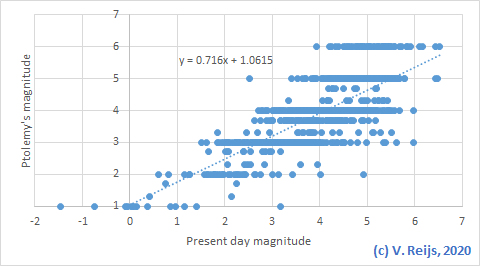
- If we include (using ARCHAEOCOSMO
package) a limiting visual magnitude (LVM) of +6 or +6.5
at zenith, the below picture shows which observations of Ptolemy
could realistically happen (depending on the star's altitude at
meridian transit):

Some 16 stars are outside the LVM of +6 (average LVM) and
AEC=0.35 (average Atmospheric Extinction Coefficient). So 98.4%
is within the LVM range of +6.
With a LVM of 6.7 (optimistic LVM) and AEC=0.25 (optimistic AEC)
almost 100% is within range.
Star coordinates and magnitudes
In this evaluation four scenarios have been checked. Each scenario
has different star coordinates (SwissEphemeris star database [close to SIMBAD] or Almagest) and/or magnitudes
(SwissEphemeris star database [close to SIMBAD] or Almagest)
for the 30 stars mentioned by Ptolemy:
- Scenario1: Coord&Magn=SIMBAD
- ScenarioA: Coord=SIMBAD, Magn=Almagest
- ScenarioB: Coord=Almagest, Magn=SIMBAD
- ScenarioC: Coord&Magn=Almagest
The Almagest's ecliptic coordinates on date
(longitude&latitude (Pratt, 2015)) were converted into
equatorial coordinates J2000.0 (Dec/RA) using the following web
page:
- Coordinate Conversions
This web pages does the conversion in one step, although it does
everything in degrees (not in hours for RA; in that case divide
the decimal format by 15).
Some evaluation points
Below are some points coming up from the evaluation. If no scenario
is explicitly mentioned it concerns ScenarioC and if no heliacal
events are explicitly mentioned it relates to EL plus MF heliacal events.
- It was tested if the mentioned entries in Ptolemy's calendar
mapped (by changing the Atmosphere Extinction Coefficient (AEC))
with Schaefer's criterion. If not,
it might be that: Ptolemy's entries are not observations;
Schaefer's criterion is wrong; a combination; or otherwise.
- For any scenario some 35% of the entries can not be
mapped on Schaefer's criterion (even using a slightly higher
acuity [1.4] than the average 17-18 year person's acuity of
1.3+/-0.2 (Ohlsson and Villarreal, 2005)). An
unrealistic AEC of smaller than 0.15 would be needed to map
the two (aka a very very very clear sky). There was only
one entry that needed an unrealistic high AEC >0.75!
- To map the calendar entries
on the Schaefer's criterion low AEC are prominent:
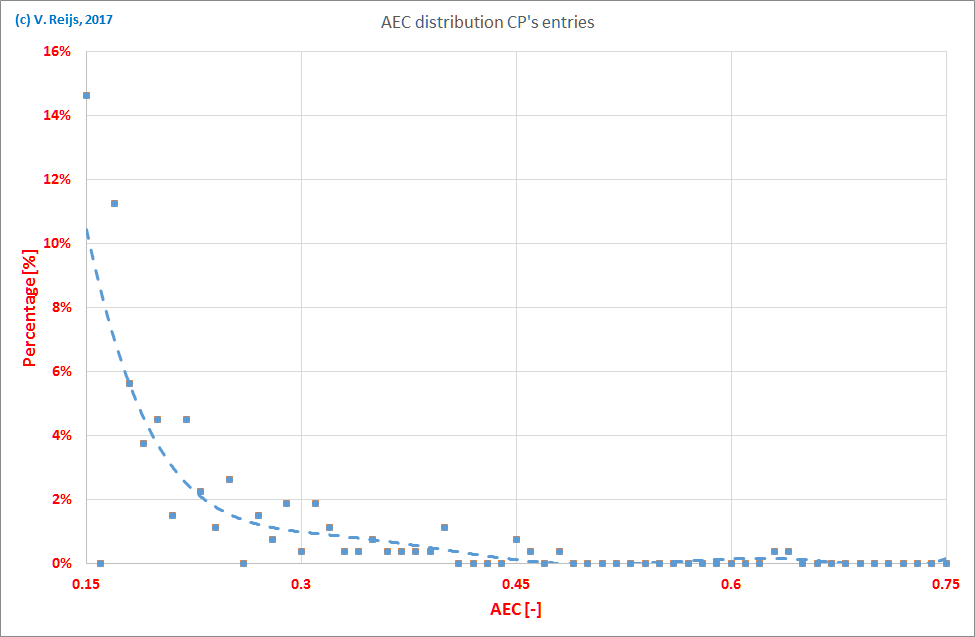
During real atmospheric conditions, a more Gaussian
distribution is expected; peaking higher than 0.15 (see for
instance this
distribution). Due to the difference in AEC (or |DAzi|)
distribution the below formula might not be easily comparable
to other formula in literature!!!
- The standard deviation of the date difference depends on the
scenario:
Scenario
|
Coord
|
Magnitude
|
Standard
Deviation [Days]
|
Scenario1
|
SIMBAD
|
SIMBAD
|
5.1
|
ScenarioA
|
SIMBAD
|
Almagest
|
3.3
|
ScenarioB
|
Almagest |
SIMBAD
|
4.8
|
ScenarioC
|
Almagest |
Almagest |
2.3
|
- The smallest standard deviation (2.3 days) of date
differences happens with ScenarioC. And using the Magnp
of Almagest reduces the date difference the most.
- The Almagest data (ScenarioC)
looks to have been used (mostly) in Ptolemy's star
catalogue, instead of or beside real observations
(Scenario1).
- Nickiforov (2017, pers. comm.) also says that Ptolemy's
calendar was build mainly around a theoretical model instead
of observations. In (Nickiforov, 2015, page 74) is stated that
no real preference on model/observation can be given.
- The standard deviation of the date difference for non-mapped
entries is not really depending on the climata. Except climata
15.5 hours has some outliners, mainly due to Rukbat and
Mirfak. These two stars are close to the horizon for climata
15.5 hours and 58CE.
- Relation Magnp and TopoAV (regardless of
|DAzi| and AEC) is:
TopoAV(Magnp)
= 8.0 + 2.7*Magnp
[deg] (1)
<Schaefer's criterion has not been used
to derive this formula>

- Nickiforov (2015, page 72) used another translation of
Ptolemy's Phases (L'Abbe Halma, 1816), his relation between Magnp and TopoAV (called by him: arc of
visibility) is:
TopoAV = 9.8 + 2.2*Magnp [deg]
(2)
- The difference between formula (1) and (2) could be due to:
differences in the entries (due to translation issues); and/or
Nickiforov only used Magnp=1 and 2, while
formula (1) is based on intermediate magnitudes (as given by
Peters and Knobel (1915, page 120)).
- Relation |DAzi| and TopoAV is (|DAzi|<100 and regardless of
Magnp and AEC):
TopoAV(|DAzi|) = 14.5 - 0.065*|DAzi|
[deg] (3)
<Schaefer's criterion has not been used
to derive this formula>
- The TopoAV for the 4 heliacal events
(MF, EL, AR and CS) seems to
stabilising at around 6.25 degrees for |DAzi| from above 100
degrees.
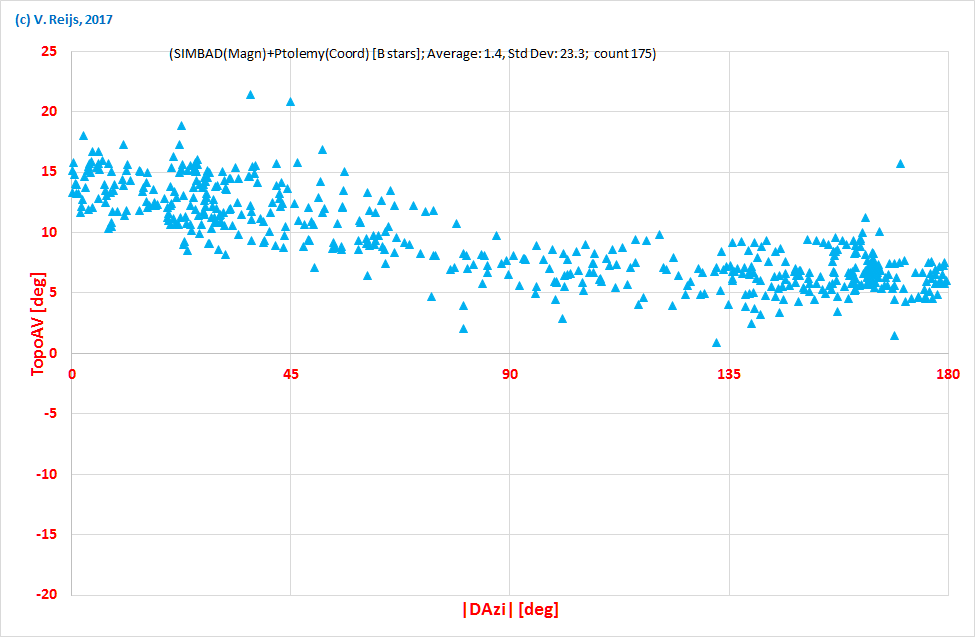
- The stabalising of the TopoAV could be due to the Earth's
shadow onto the atmosphere starting from |DAzi| of 90 degrees.
Some scattering extends this 90 to some 100 degrees perhaps.
Schaefer has a stabalising angle also around 100 deg for Btwi
(Schaefer, formula 15c)
- Nickiforov (2015, page 73) used another translation of
Ptolemy's Phases (L'Abbe Halma, 1816), his relation between
|DAzi| and TopoAV (called by him: arc of visibility) is:
TopoAV(Magnp=1) = 13.26 - 0.090*|DAzi|
[deg] (4)
TopoAV(Magnp=2) = 15.40 - 0.096*|DAzi|
[deg] (5)
- The difference between formula (3) and (4)&(5) could be
due to: differences in the entries (due to translation issues);
and/or Nickiforov only used Magnp=1 and 2,
while formula (3) is based on intermediate magnitudes (as given
by Peters and Knobel (1915, page 120)).
- If the Excel's GRG Nonlinear Solver is used to determine the
TopoAV dependency on mp and |DAzi| (upto
100deg) the following combined formula is the result (regardless
of AEC):
TopoAV(Magnp,|DAzi|)
= 10.5 + 2.3*Magnp -
0.051*|DAzi| [deg] (6)
<Schaefer's criterion has not been used
to derive this formula>
- Nickiforov (2015, page 74) gives as combined formula:
TopoAV(Magnp,|DAzi|) = 9.8 + 2.2*Magnp - 0.093*|DAzi| [deg]
(7)
- The (small) difference between formula (6) and (7) could be
due to: differences in the entries (due to translation issues);
and/or Nickiforov only used Magnp=1 and 2,
while formula (6) is based on intermediate magnitudes (as given
by Peters and Knobel (1915. page 120)); and/or difference in the
analysis method to determine the formula coefficients.
- If looking at ScenarioB, we can determine a combined formula
for the entries that can be mapped on Schaefer's criterion (aka
Ptolemy's calendar entries that could have been observed
according to Schaefer's criterion). This gives an idea of
a three parameter behavior of Schaefer's criterion for TopoAV
and Arcus
Visionis:
TopoAV(Magn,|DAzi|,AEC) = 8.0 +
1.8*Magn -
0.024*|DAzi| + 17.7*AEC [deg] (8)
Arcus Visionis(Magn,|DAzi|,AEC)
= 9.6 + 0.69*Magn - 0.016*|DAzi| - 3.6*AEC
[deg] (9)
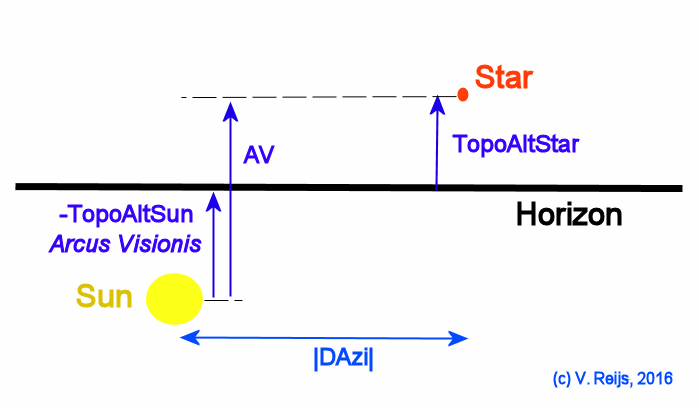
- Looking at the above formulas (8) and (9): the Arcus
Visionis (9) is much less depending on Magn, |DAzi| and
AEC than the TopoAV (8). The Arcus Visionis is some five
times less dependent on AEC than the TopoAV! This was also
derived in another
analysis.
- Looking at the above: the single
parameter criterion of Schoch (1924, page 734) misses the
significant influence of |DAzi| (assumed smaller than 25
degrees) and AEC (assumed low and constant?). The heliacal
angle derived by Schoch are tabled here.
- If we combine the (Schaefer's criterion) mapped calendar
entries of Ptolemy and observation
of Kolev the resulting graph, can be seen here.
- The AR&CS events mentioned in Ptolemy's calendar still
need an evaluation. There are some 270 of them and they might
give a good insight how there were observed/derived. But
remember these entries could be calculations instead of
observations.
- A teaser of the dependency of TopoAV on
magnitude for AR&CS events, can be seen below:
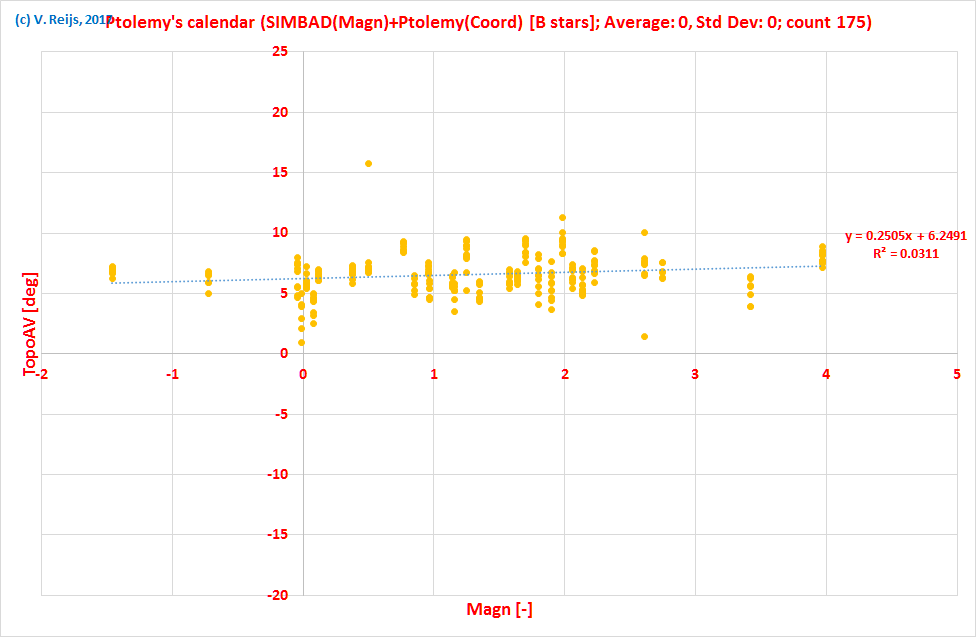
One can clearly see the stability of the TopoAV, which is around
6.25 degrees. Such a stability is not expected with real
observations. See also here.
- The sequence of Phases (recorded for
the stars entries in Genimus' calendar [Ptolemy, 1993])
determines the Object Type
of the mentioned 30 stars (and 5 different latitudes). The
distribution of Types mentioned in the Ptolemy's calendar can be
seen in below figure (in total some 140 Type entries):
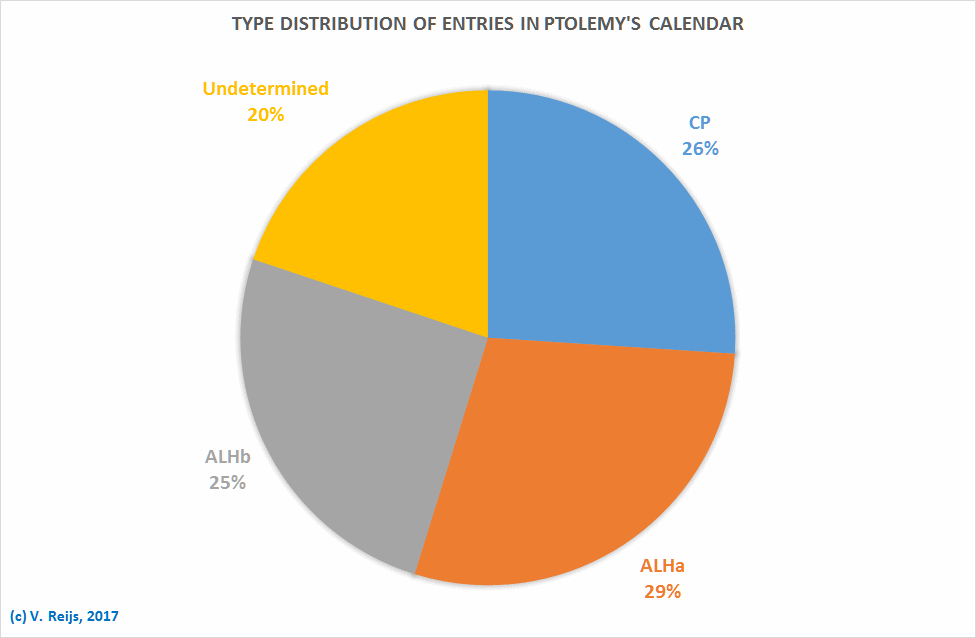
'Undetermined' means that not enough entries were provided to
determine any Type (ALH: Arisen
and Laying Hidden and CP: Curtailed
Passage). But most of the 'Undetermined' could be
changed into 'likely (sub)Type' by deducting from other entries,
given the below picture:

- In below picture one can see the stars (filled symbols) and
their Phase sequence mentioned by Ptolemy, all fit nicely in the
proper (sub)Type region.There are some sets of calendar entries
that show that the Type of a star (open symbols: Menkalinan,
Altair, Alpheratz, Betelgeuse, Alphard and Rukbat) changes
depending on the climata (geographical latitude): in all cases
it changed to ALHb for climata 14 or 13.5 hours (geo.
lat=23.85). Two stars (Bellatrix and Procyon) are also very
close to such behavior: 1 or 2 days.
See below (AEC=0.15; climata 13.5h; and if a symbol is on the
borderline, its Declination is outside the border, graph
determined using ARCHAEOCOSMO):
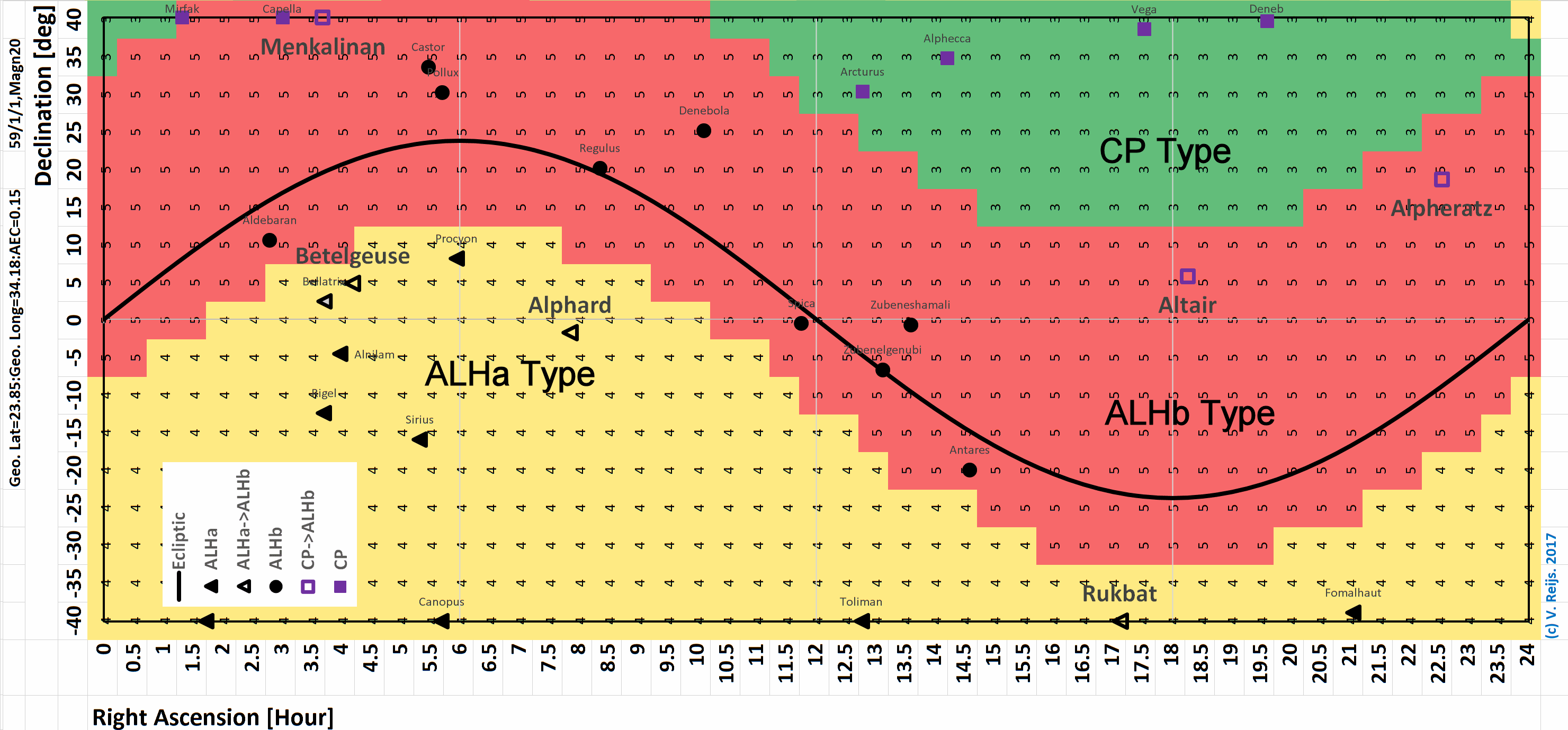
If the AEC would be smaller, the red band would be lowered and
closer mapping the stars that have changing Types. This might be
another hint that Ptolemy's entries were not
observations but calculations.
Conclusion
Ptolemy's calendar entries might be based on theory, but his theory
was quite good: he might not (always) have included real
observations, but the sequence of phases is mapping well even for
the changes happening for different climata. The stabilising of the
TopoAV for |DAzi| greater than 100 deg, also looks to happen with
the modern theories. The TopoAV of AR&CS events seems to be
somewhat off, as it looks to be constant for all stars, which might
not be true for (modern) reality. The problem though is that we
don't know (yet) the former definition of these events.
References
Bortle, J.E., 2001. The Bortle Dark-Sky Scale. Sky &
Telescope, https://web.archive.org/web/20130611180652/http://media.skyandtelescope.com/documents/BortleDarkSkyScale.pdf
Clark, R.N., Visual astronomy of the deep sky, Cambridge
University Press, 1990
Geminus, Calendar or register attributed to Geminus, Trans.
Robert Schmidt, The Golden Hind Press, 1993
Nickiforov, Michael G., 'Analysis of the calendar C.
Ptolemy: Phases of the fixed stars', Bulgarian Astronomical
Journal 20 (2014): 68-85.
Ohlsson, Josefin, and Villarreal Gerardo, 'Normal visual acuity in
17-18 year olds', Acta ophthalmol Scand. 83, no. 4 (2005): 487-91.
Pedersen, Olaf, 'The Almagest in translation', Journal of
history of astronomy xviii (1987): 59-63.
Peters, Christian Heinrich Friedrich, and Knobel Edward Ball,
Ptolemy's catalogue of stars: A revision of the Almagest,
Washington: The Carnegie Institution, 1915.
Pratt, John P., 'The Ptolemy star catalog', 2015 http://www.johnpratt.com/items/astronomy/ptolemy_stars.html,
accessed on 16 March, 2017.
Protte, P., Analysis and follow up observations of historical star
catalogues: Featuring a reconstruction of the Ptolemaic armillary
sphere, June 2019, Friedrich Schiller university Jena (not yet
published)
Ptolemy, Claudius, Apparitions des fixes et annonces: Traduites du
Grec de Ptolemy. Translated by M. L'Abbé Halma, Paris, 1816.
Ptolemy, Claudius, The phases of the fixed stars. Translated by
Robert Schmidt. Edited by Robert Hand: The golden Hind press,
1993.
Schaefer, Brad E., 'Astronomy and the limits of vision',
Archaeoastronomy: The journal of astronomy in culture XI (1993):
78-91.
Schoch, Carl. 1924. 'The 'Arcus Visionis' of the planets in
the Babylonian observations', Monthly Notices of the Royal
Astronomical Society, Vol 84: pp. 731-34.
Acknowledgements
I would like to thank people, such as Rob
van Gent, Dieter
Koch, Michael Nickiforov,
John Pratt, Afrodite Sevasti
for their help and constructive feedback. Any remaining errors in
methodology or results are my responsibility of course!!! If you
want to provide constructive feedback, let me
know.
Disclaimer and Copyright
 Home
Home Up
Up Search
Search Mail
Mail
Major content related changes: March 16, 2017









